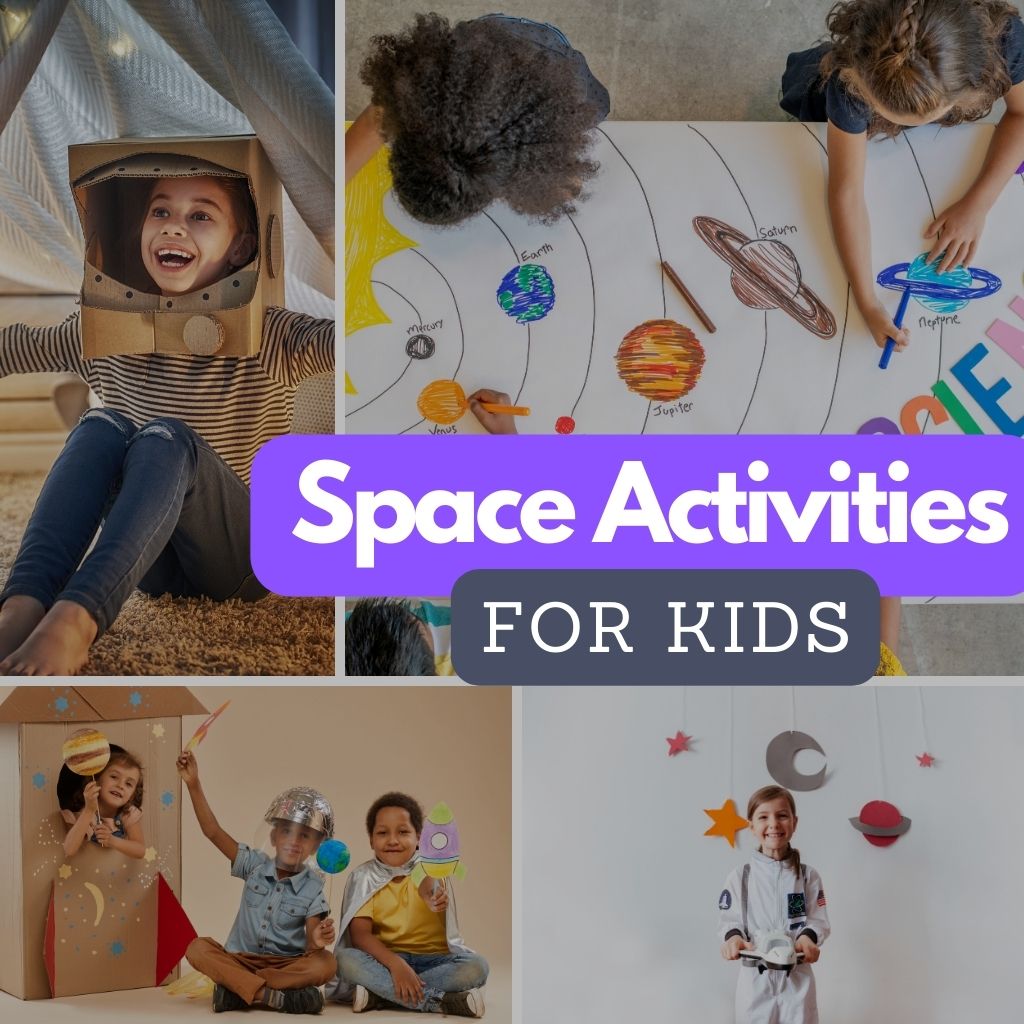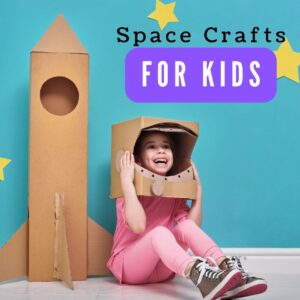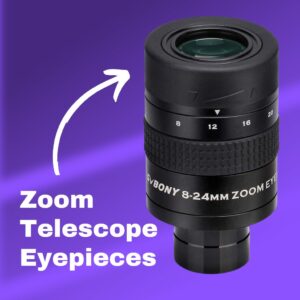This site contains affiliate links to products. I may receive a commission for purchases made through these links.
Space is becoming increasingly accessible and fascinating, it’s the perfect time to kindle your children’s interest in the mysteries of the universe.
As educators, parents, or guardians, you play a crucial role in sparking and nurturing their love for science.
From creating a spinning solar system in their bedroom to becoming a rocket scientist for a day, organizing space activities will help kids understand space science in a fun and engaging way.
They’ll learn about the moon phases, play with galaxy slime, design bottle rockets, and much more.
This article is a treasure trove of space activities that will inspire a generation of future astronauts, scientists, and engineers.
We have ensured to include a variety of hands-on activities and digital resources, aiming to cater to different learning styles and environments.
Read on to find out what works best for you!
Space activities for toddlers
The boundless curiosity of toddlers can be nurtured with simple, engaging activities.
These exercises will help them grasp the foundational concepts of space while also having a lot of fun!
At this age, space activities should be simple, sensory, and packed with fun.
Here are some delightful ways to introduce toddlers to the concept of outer space.
1. Create sensory space bins
Creating an outer space-themed sensory bin such as this Creativity for Kids Sensory Bin is a fantastic way for toddlers to start exploring space. The tactile exploration is great for fine motor skills development and makes the concept of space so much fun to explore.
Fill a large container with items such as moon sand, shiny stars, and space-themed toys.
Then do the following:
- Add your filler: Begin by adding your filler to the bin. You can fill it to about halfway, leaving plenty of room for your toddler to dig, sift, and explore.
- Add space-themed items: Place various space-themed toys and items in the bin. Think about adding toy astronauts, rocket ships, glowing stars, or anything else that fits your space theme.
- Introduce tools: For an extra layer of interaction, add tools like spoons, cups, or mini rakes. This can help your toddler with their fine motor skills as they dig and sift through the bin.
- Engage your toddler: Invite your toddler to explore the bin. Ask them questions about the items they find to spark their curiosity and engagement with the space theme.
- Clean up: After playtime is over, make sure to store any small toys safely and cover the bin to keep the filler clean for next time.
Remember, always supervise your toddler during playtime to ensure they are safe and getting the most out of the activity!
2. Paint space
Let your toddlers create their own universes with finger paint. Use Crayola Washable Finger Paints to encourage them to draw stars, planets, and rockets.
This activity will help develop their hand-eye coordination while letting their creativity soar.
3. Create Galaxy slime
Get their little hands messy with sparkly, stretchy galaxy slime. You can create this by doing the following:
- Gather your supplies: You’ll need the Elmer’s Galaxy Slime Starter Pack or similar, which includes clear glue, glitter glue, and “magic” solution.
- Prepare your work area: Cover your work surface with newspaper or a disposable tablecloth. Slime can get a bit messy!
- Mix the glues: Empty the entire bottle of a single color of glitter glue into a container.
- Add ‘magic’ solution: Add the ‘magic’ solution (activator) that comes in the kit. Usually, this is added in small increments while stirring until the slime begins to form.
- Mix thoroughly: Stir until your mixture becomes harder to stir and slime begins to form.
- Knead the slime: Take the slime out and begin to knead with both hands. If needed, add more ‘magic’ solution a little at a time until you get a consistency you’re happy with.
- Repeat for other Colors: Repeat the process with the other glitter glue colors.
- Combine your slime: Once all your colors are made, lay them side by side, then mix them together to get that galaxy effect.
While making slime is fun, it should always be done under adult supervision, as the ingredients can be harmful if mishandled.
4. Space-themed storytime
Create a daily routine with books like There’s No Place Like Space: All About Our Solar System. Its appealing illustrations and simple rhymes will captivate the toddlers and fuel their love for space.
You may also like: 49 Best Astronomy Books for Kids: Top Picks Sorted by Age
5. Moon rock hunt
Create a mini-moon rock hunt in your backyard or a safe outdoor area. Use gray craft paper or aluminum foil to wrap small rocks, creating the illusion of moon rocks.
Hide these “moon rocks” around the area and let the toddlers go on a treasure hunt.
As they find each moon rock, talk about how astronauts explore the moon and bring back samples.
6. Space puzzles
Introduce simple space-themed puzzles with large, colorful pieces. These can feature planets, rockets, and astronauts. Puzzles help toddlers improve their problem-solving skills while having fun.
7. Constellation art
Use black construction paper and white chalk or chalk markers to draw basic constellations on the paper. Show the toddlers how to connect the dots to create simple star patterns.
Talk about how people used to look at the stars to tell stories in the past.
8. Astronaut dress-up
Set up a dress-up corner with astronaut costumes and props like helmets, gloves, and toy space tools. Let the toddlers take turns being “astronauts” and encourage imaginative play as they explore their own space adventures.
9. Moon sand playdough
Create a playdough mixture that resembles moon sand by mixing regular playdough with a bit of sand.
Add silver glitter for a touch of sparkle. Provide toy molds of planets and rockets so toddlers can create their own space scenes.
10. Paper plate planets
Prepare paper plates and paint in various colors to represent different planets. Help the toddlers paint each plate to resemble a planet. As you paint, share a simple fact about each planet.
Hang the finished paper plate planets on a string to create a colorful solar system display.
11. Sensory spacewalk
Set up a sensory space walk indoors using blue or black blankets as “space.”
Attach glow-in-the-dark stars to the blankets and let the toddlers walk, crawl, or jump from one “planet” to another while pretending to explore outer space.
See more: 41 Fun Space Activities for Kindergarten Kids
Space activities for preschoolers
Preschoolers love hands-on learning and are curious explorers.
Here are some space themed activities to fuel their enthusiasm for the solar system.
12. Baking soda moon rocks
Creating moon rocks out of baking soda, and water is a fun way to introduce chemical reactions. This activity is a fun and interactive way to teach kids about chemical reactions, plus it adds that space-themed twist to keep things interesting.
Here is how to have fun with this activity:
- Gather your supplies: You’ll need baking soda, water, food coloring (preferably black or gray), glitter, vinegar, and a dropper. For containment, the Easy Carry Art Tray by Creatology can be a useful accessory.
- Prepare baking soda mixture: In a bowl, combine about 2 cups of baking soda with a small amount of water. Add the water gradually until you get a crumbly yet moldable consistency.
- Add color and sparkle: Add a few drops of food coloring and some glitter into the mix for that moon-like appearance.
- Form the moon rocks: Using your hands, form small rocks from the baking soda mixture. Allow these to dry completely, preferably overnight.
- Prepare for the Experiment: Once your moon rocks are dry, place them in the Creatology tray or a similar container. Fill a dropper with vinegar.
- Start the Experiment: Let your child drop vinegar onto the moon rocks using the dropper. Watch as the moon rocks fizz and bubble, creating a fun and engaging science experiment.
Always supervise kids during these kinds of activities to ensure they are safe and to guide them through the learning process.
13. DIY rockets
What could be more exciting than launching your own rocket? With just a film canister, water, and Alka-Seltzer, preschoolers can safely launch a small rocket.
This activity is a great way to explain and demonstrate propulsion and gas reactions to preschoolers.
Here is what to do:
- Gather your supplies: For this activity, you’ll need an empty film canister (the type with the cap that fits inside works best, such as the Houseables Film Canisters with Caps), water, and Alka-Seltzer tablets.
- Prepare your rocket: Remove the cap from the film canister and fill the canister halfway with water.
- Get ready for launch: Break your Alka-Seltzer tablet into a few pieces. Tell your preschooler that once the Alka-Seltzer is added to the water, it will begin to fizz, and we need to cap the canister quickly to get it ready for launch.
- Launch: Quickly drop the Alka-Seltzer pieces into the canister, immediately snap the cap on tight, and then stand the canister cap-side-down on a hard surface.
- Stand back and watch: Quickly step back and watch your rocket blast off!
While this experiment is relatively safe, adult supervision is still required.
14. Planetarium visit
Take your preschoolers to a local planetarium. This is a fun and interactive way to learn about space and the solar system. If a physical visit isn’t possible, try a virtual tour.
15. Planet sorting
Introduce them to the planets of our solar system through a sorting activity. Flashcards of planets can be sorted by size, color, or order in the solar system.
16. Astronaut obstacle course
Create an astronaut-themed obstacle course in your backyard or a playroom. Set up challenges like “moonwalking” by placing pieces of cardboard on the ground, “space rock hopping” between hula hoops, and “zero-gravity jumping” on a trampoline.
Preschoolers will have a blast while improving their motor skills.
17. Alien playdough creations
Make green or colorful playdough and provide various craft supplies like googly eyes, pipe cleaners, and foam shapes.
Encourage preschoolers to create their own alien creatures, fostering creativity and fine motor skills.
18. Space-themed yoga
Engage preschoolers in a space-themed yoga session. Guide them through yoga poses that mimic astronauts, rockets, shooting stars, and even planets. Incorporating storytelling while doing these poses can make it even more exciting.
19. Moon phases Oreo activity
Teach preschoolers about the different phases of the moon with an edible activity using Oreo cookies. Show them how the cream filling represents the moon’s changing appearance as it orbits the Earth.
20. Planet art collage
Provide magazines, newspapers, and colored paper along with pictures of planets. Have preschoolers cut out the planets and glue them onto a larger piece of paper to create their own planet collage.
21. Moon phase cookies
Bake sugar cookies and shape them like the different phases of the moon (full, crescent, half, etc.). Let preschoolers decorate each cookie to match the moon’s appearance with icing or frosting.
22. Starry night sky craft
Help preschoolers create a “starry night” scene by painting a piece of dark construction paper with glue and sprinkling it with glitter. Add star stickers or punched-out stars to complete the celestial atmosphere.
23. Space-themed bingo
Create a bingo game with space-themed images like planets, stars, rockets, and astronauts. Play the game to teach preschoolers about different elements of space while having a lot of fun.
You may also like: 25 Space Themed Games for Kids
Space activities for elementary school kids
For elementary school children, space activities can be more engaging and complex. Elementary school children are ready for more challenging space activities.
These fun space activities will keep them engaged and fuel their interest in the universe.
24. Stargazing
Star gazing can spark curiosity and inspire children’s lifelong love for astronomy.
Allowing elementary school children to explore the night sky themselves can help them learn about constellations, identify planets, and even spot meteor showers.
Here are a few beginner telescopes suitable for elementary school kids:
- Emarth 70mm Astronomical Refractor Telescope
- Celestron Inspire 100AZ Refractor
- Solomark Telescope for Kids
Guiding children through their stargazing adventures ensures a safe and educational experience.
With these excellent telescopes, the wonders of the universe are just a gaze away!
To read more about the best telescopes for kids, check out this article: 11 Best Telescopes for Kids in 2023 (Sorted by Age)
25. Create a moon journal
Invite kids to observe the moon’s phases over several weeks. Provide a journal where they can sketch the moon’s appearance each night. Discuss how the moon’s position changes and how this relates to its different phases.
26. Bake celestial cake
Let the kids engage in a creative and delicious activity by baking their own celestial-themed cake. Provide a plain round cake, frosting in various colors, and edible glitter or sprinkles.
Guide them to decorate the cake to resemble the vibrant colors of planets, stars, and galaxies. As they design their own edible universe, they’ll learn about the diversity of celestial bodies while enjoying a sweet treat.
This hands-on activity combines artistic expression with a tasty learning experience.
Read also:
- 13 Space Themed Cupcake Designs & Flavors (w/Recipes!)
- Celestial Delights: 20 Space-Themed Cake Ideas
27. DIY solar system model
Creating a 3D solar system model is an educational and fun project. Children can paint and assemble the 4M Solar System Planetarium kit, helping them understand the planets and their positions in the solar system.
28. Design a space mission
Divide kids into teams and challenge them to design a fictional space mission.
They can research a destination in the solar system, plan the spacecraft’s design, and create a presentation to explain their mission’s purpose and goals.
29. Space puzzles and brain teasers
Introduce space-themed puzzles and brain teasers that require critical thinking and problem-solving. Crossword puzzles, word searches, and logic puzzles can teach kids new space facts while keeping them engaged.
30. Craft a spinning solar system
Organize an interactive project by constructing a model of the solar system that spins, aiding kids’ comprehension of planet orbits.
31. Build a balloon-powered space rover
Merge creativity and science by encouraging them to design and assemble their balloon-propelled space rovers, offering an introduction to foundational engineering concepts.
32. Craft yarn-wrapped planets
Encourage artistic expression as children fashion yarn-wrapped renditions of distinct planets, combining fine motor skill development with planetary knowledge.
Space activities for middle school kids
By middle school, students are ready for more in-depth and complex projects. These activities will provide a deeper understanding of space and physics.
33. Blackhole exploration
Using online simulations like Universe Sandbox, middle school students can study the mysterious phenomenon of black holes. This virtual exploration allows them to understand gravity, light, and the space-time fabric.
34. Explore space with virtual reality
One of the most immersive ways for children to learn about space is through virtual reality (VR). With the assistance of a VR headset, such as the Meta Quest 2, children can explore different planets, float in zero gravity, and even walk on the surface of Mars without leaving their classrooms or homes.
Apps like “Titans of Space PLUS” on the Oculus platform offer an amazing solar system tour.
This is an amazing way to visualize the scale of planets, learn about their unique features, and discover fascinating facts about our solar system.
It’s an out-of-this-world experience that brings the universe to life in front of their eyes!
To ensure safety, it’s crucial to guide children in using VR technology and take regular breaks to avoid eye strain.
With appropriate supervision, this can be a fun and effective method to fuel their love for space science.
35. DIY telescope
Building their own telescope can be a fun and challenging project for middle school students. This Carolina Make Your Own Refractor Telescope Kit comes with all the necessary parts and detailed instructions.
This task requires precision and patience and can pique their interest in optics and engineering.
36. Solar oven project
Middle school students can build their own solar oven to understand how sunlight can be used as a source of heat. This simple project can spark discussions about renewable energy and the power of the sun.
Materials Needed:
- A pizza box
- Aluminum foil
- Clear plastic wrap
- Black construction paper
- Glue
- Tape
- Scissors
- Ruler
- Stick or straw for propping up the flap
Here is how to do it with the kids:
- Cut a flap: On the top of the pizza box, cut out a flap on three sides, leaving about an inch of border from the edge of the box. Leave the fourth side of the flap attached to the box.
- Cover with foil: Cover the inside of the flap and the interior of the box with aluminum foil. Make sure to smooth out any wrinkles. This will help reflect the sunlight into the box.
- Clear plastic cover: Open the flap and tape a layer of clear plastic wrap over the opening you created. This helps to let sunlight in while trapping the heat inside.
- Add the black paper: Glue a piece of black construction paper to the bottom of the inside of the box. This will absorb the heat.
- Cook: Place what you want to cook (like a marshmallow or hot dog) on the black paper, close the box, prop open the foil-covered flap using a stick or straw, and angle it towards the sun.
Remember, your food might take a while to cook, so be patient. This experiment is a great way to understand the concept of solar power and renewable energy.
Enjoy this fun and educational activity under the sun!
Always be careful when handling potentially hot items.
37. Space coding
Students can code their own space-themed game using Scratch. This project is an excellent way to incorporate digital skills with their interest in space, making learning more integrated and fun.
38. Design a space colony
Challenge middle school students to design a self-sustaining space colony. They’ll need to consider factors like life support systems, food production, energy sources, and recreation.
This project promotes critical thinking and problem-solving while exploring the challenges of long-term space habitation.
39. Moon lander simulation
Using physics simulation software like Algodoo, students can create their own moon lander and simulate its descent onto the lunar surface. They’ll need to consider gravity, thrust, and landing dynamics while aiming for a successful touchdown.
40. Space debate
Organize a space-themed debate where students research and present arguments on topics like the importance of space exploration, the ethics of colonizing other planets, or the potential benefits of asteroid mining.
This activity encourages research, public speaking, and critical thinking skills.
41. Watch a space movie
Organize a movie screening of an age-appropriate space movie. “Interstellar” (2014), directed by Christopher Nolan, is a thought-provoking option suitable for middle school kids.
The film explores space travel, time dilation, and the human spirit’s quest for exploration.
For additional choices of space movies suitable for children, check out: 44 Space Movies for Kids (Fun & Educational)
42. Build a model rover
Challenge students to build a model rover using everyday materials like cardboard, wheels, and simple motors.
This hands-on project allows them to understand the engineering behind space exploration vehicles and encourages creativity in designing their rover’s functions.
43. Create a space documentary
Divide students into groups and assign each group a planet or celestial body to research.
Have them create a short documentary-style presentation about their assigned celestial body, including its characteristics, history of exploration, and potential for future exploration.
Read also: 33 Best Space Documentaries (Must Watch!)
44. Space poetry and creative writing
Encourage students to express their fascination with space through creative writing. They can write space-themed poetry, short stories, or even a fictional journal of an astronaut’s journey. This activity combines language arts with their interest in space exploration.
45. Space career exploration
Invite professionals from various space-related fields (astronomy, engineering, astrophysics, etc.) to share their experiences and career paths with students.
This activity provides insight into potential career opportunities in the field of space exploration.
46. Build an astronaut training Center
Help Middle schoolers conceive and establish a simulated astronaut training hub, delving into the demanding preparatory routines for space expeditions.
47. Organize a solar system flash-card game
Elevate learning with an enjoyable game that challenges players to match planets with their respective descriptions, fortifying their understanding of the solar system understanding.
Takeaway: Initiate fascinating outer space activities for kids to fuel their love for science and have so much fun
Throughout this guide, we’ve journeyed across the universe, explored moons and planets, designed rockets, and even examined black holes from our homes or classrooms.
Each fun space activity, designed for specific age groups, aims to fuel kids’ love for space and science. Not only are they educational, but they’re also enjoyable, reinforcing the idea that learning can be, and indeed should be so much fun.
As the Greek philosopher Socrates once said, “Wonder is the beginning of wisdom.”
When we foster a sense of wonder about the universe in our children, we’re setting them off on an exciting journey of lifelong learning.
You may also like:




